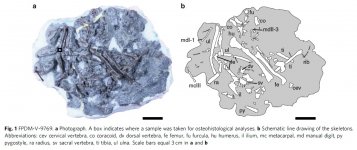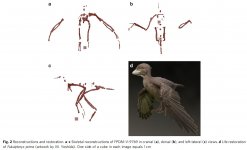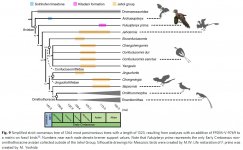Fred Ruhe
Well-known member

Takuya Imai, Yoichi Azuma, Soichiro Kawabe, Masateru Shibata, Kazunori Miyata, Min Wang & Zhonghe Zhou, 2019
An unusual bird (Theropoda, Avialae) from the Early Cretaceous of Japan suggests complex evolutionary history of basal birds
Communications Biology. 2: Article number 399.
doi:10.1038/s42003-019-0639-4.
Abstract and free pdf: https://www.nature.com/articles/s42003-019-0639-4
The Early Cretaceous basal birds were known largely from just two-dimensionally preserved specimens from north-eastern China (Jehol Biota), which has hindered our understanding of the early evolution of birds. Here, we present a three-dimensionally-preserved skeleton (FPDM-V-9769) of a basal bird from the Early Cretaceous of Fukui, central Japan. Unique features in the pygostyle and humerus allow the assignment of FPDM-V-9769 to a new taxon, Fukuipteryx prima. FPDM-V-9769 exhibits a set of features comparable to that of other basalmost birds including Archaeopteryx. Osteohistological analyses indicate that FPDM-V- 9769 is subadult. Phylogenetic analyses resolve F. prima as a non-ornithothoracine avialan basal to Jeholornis and outgroup of the Pygostylia. This phylogenetic result may imply a complex evolutionary history of basal birds. To our knowledge, FPDM-V-9769 represents the first record of the Early Cretaceous non-ornithothoracine avialan outside of the Jehol Biota and increases our understanding of their diversity and distribution during the time.
Enjoy,
Fred
An unusual bird (Theropoda, Avialae) from the Early Cretaceous of Japan suggests complex evolutionary history of basal birds
Communications Biology. 2: Article number 399.
doi:10.1038/s42003-019-0639-4.
Abstract and free pdf: https://www.nature.com/articles/s42003-019-0639-4
The Early Cretaceous basal birds were known largely from just two-dimensionally preserved specimens from north-eastern China (Jehol Biota), which has hindered our understanding of the early evolution of birds. Here, we present a three-dimensionally-preserved skeleton (FPDM-V-9769) of a basal bird from the Early Cretaceous of Fukui, central Japan. Unique features in the pygostyle and humerus allow the assignment of FPDM-V-9769 to a new taxon, Fukuipteryx prima. FPDM-V-9769 exhibits a set of features comparable to that of other basalmost birds including Archaeopteryx. Osteohistological analyses indicate that FPDM-V- 9769 is subadult. Phylogenetic analyses resolve F. prima as a non-ornithothoracine avialan basal to Jeholornis and outgroup of the Pygostylia. This phylogenetic result may imply a complex evolutionary history of basal birds. To our knowledge, FPDM-V-9769 represents the first record of the Early Cretaceous non-ornithothoracine avialan outside of the Jehol Biota and increases our understanding of their diversity and distribution during the time.
Enjoy,
Fred
Last edited:






